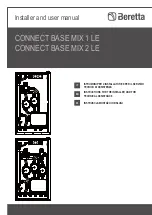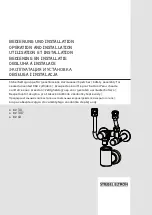
ENERGY TOP B
68
EN
cod. 3540S738 - Rev. 00 - 01/2014
Accessing the electrical terminal block
The electrical terminal block is located inside a sealed box at the bottom left of the cab-
inet. Make the electrical connections as shown in the wiring diagram on sec. 65 and run
the cables through the special cable glands.
fig. 31 - Electrical terminal block
42
DHW temperature sensor (not supplied)
72
Room thermostat (not supplied)
72b
Room thermostat (not supplied)
95
Diverter valve (not supplied)
A
= Heating phase
B
= DHW phase
C
= Neutral
Note:
For valves with 2 wires and spring return, use the connections B and C
130
DHW circulating pump (not supplied)
138
External probe (not supplied)
139
Remote timer control (not supplied)
298
Cascade temperature sensor (not supplied)
299
Input 0-10 Vdc
300
Burner lit contact (voltage-free contact)
301
Fault contact (voltage-free contact)
302
Remote reset input (230 Volt)
306
Heating system circulating pump (not supplied)
307
Heating system second circulating pump (not supplied)
For connection in cascade (MAX. 5 MODULES)
1.
Connect the modules as shown in fig. 32 (example with 4 modules)
fig. 32 - Connection in cascade
A
1st Module
B
2nd Module
C
3rd Module
D
4th Module
2.
Carry out all the electrical connections (terminals 4 to 24) on module no. 1
3.
On the remaining modules only connect the power supply and possible contacts for:
burner lit (300), fault contact (301) and remote reset input (302).
4.
Switch on the power to the entire cascade
5.
After the "FH" procedure, check correct operation of the cascade:
•
Module 1: arrow symbol at top left of the display
•
Module 2: arrow symbol at bottom right of the display
•
Module 3: arrow symbol at bottom right of the display
•
Module 4: arrow symbol at top right of the display
If this does not occur, disconnect the power and check the wiring in fig. 32.
Settings
All adjustments must be made on all the modules.
Possible faults
If the electrical connection of a module is disconnected for any reason, module 1 will ac-
tivate fault
F70
.
If the electrical connection of a module is disconnected for any reason, the next module
will activate fault
F71
.
3.5 Flue connection
Important
The unit is a B23 type with combustion air drawn from the installation room and fume ex-
haust by means of a fan (operation with flue under pressure) and must be connected to
one of the discharge systems indicated below. Before proceeding with installation, check
and carefully comply with the local regulations and provisions. Also comply with the pro-
visions concerning the positioning of wall and/or roof terminals and the minimum distanc-
es from windows, walls, ventilation openings, etc.
Manifold, ducts and flue must be suitably sized, designed and made in compliance with
the current standards. They must be made of suitable materials, i.e. resistant to heat and
corrosion, smooth on the inside and hermetic. In particular, joints must be condensate-
proof. Also provide for suitable condensate drainage points, connected through a trap to
prevent the condensate produced in the flues from running into the generators.
B
The unit is equipped with one (models
ENERGY TOP B 80 - 125
) or two (mod-
els
ENERGY TOP B 160 - 250
) separate Ø80 flue connections for the two burn-
er - exchanger units.
The combustion circuits of the two units are completely independent. When
joining the two fume outlets to a single flue or manifold (in case of a single mod-
ule or connection in cascade) it is necessary to install a fume anti-backflow val-
ve
on each outlet to
prevent operation anomalies or the creation of hazardous
conditions. Make sure to use the optional FERROLIkits , provided with special
anti-backflow valves.
A
Before carrying out the flue connection, make sure to fill the condensate trap
with approx. 0.5 litres of water through the flue connections.
Connection with separate pipes
Separate Ø80 ducts can be connected directly to the unit Insert the seal 1KWMA84A on
the Ø80 pipes leaving the unit and make it adhere to the upper wall of the cabinet
Before installation, make sure the maximum permissible length has not been exceeded,
by means of a simple calculation:
1.
Establish the layout of the system of split flues, including accessories and outlet ter-
minals for each of the two burner/exchanger bodies
2.
Consult the table 5 and identify the losses in meq (equivalent metres) of every com-
ponent, according to the installation position
3.
Check that the sum total of losses is less than or equal to the maximum permissible
length in table 4.
Table. 4 - Maximum length of separate ducts
Table. 5 - Accessories
4
5
;
7
8
9
10 11
12
13 14
15 1;
17 18 19 20 21 22 23 24
F
F F
F
300
301
95
302
299
139
72
138
298
42
25 2; 27 28 29 30
72B
130/307
306
A
B
(
25 2; 27 28 29 30
25 2; 27 28 29 30
25 2; 27 28 29 30
25 2; 27 28 29 30
A
B
(
6
Separate ducts
For each single Exchanger/Burner Body
ENERGY TOP B 80 - 160
ENERGY TOP B 125 - 250
Max. permissible length
20 m
eq
10 m
eq
Losses in m
eq
Fume exhaust
Vertical
Horizontal
Ø 80
PIPE
1 m M/F
1KWMA83W
1.6
2.0
BEND
45° M/F
1KWMA65W
1.8
90° M/F
1KWMA01W
2.0
PIPE SECTION
with test point
1KWMA70W
0.3
TERMINAL
fumes, wall with antiwind
1KWMA86A
5.0
FLUE
Split air/fumes 80/80
1KWMA84U
5.0
Содержание ENERGY TOP B 125
Страница 23: ......
Страница 24: ......
Страница 25: ...FERROLI S p A Via Ritonda 78 a 37047 San Bonifacio Verona ITALY www ferroli it ...










































